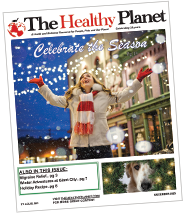
By Dan Zarlenga, Missouri Department of Conservation
Photo Caption: Bird lovers of all ages can participate in the annual Christmas Bird Count. Photo by David Stonner, Missouri Department of Conservation.
Christmas was once not so merry for birds and wildlife. In 1800s America, a tradition developed called the “side hunt”. Each Christmas two teams, armed with rifles, would take each side of a field. The object? Shoot as many birds and other wildlife as possible in a given time. The team with the biggest haul of carcasses would win the holiday contest. During this time of unregulated hunting, species like the passenger pigeon were on their way to extinction.
One man decided it was time to turn the carnage around and transform killing into counting. In 1900, ornithologist Frank Chapman proposed that people should set afield to count as many birds as possible instead and use that data to inform scientific study. One of the most significant and enduring citizen science movements was born—the Christmas Bird Count.
On Christmas Day 1900, a modest number of 27 participants from 25 locations in the United States and Canada tallied some 89 species of birds. The Show-Me-State played a part in this historic event. One of those very first 25 Christmas Bird Count locations was the town of La Grange, in northeast Missouri.
The National Audubon Society eventually began to organize the effort. Within a hundred years, by the winter of 2000-2001, the annual count had expanded to 1,823 places in 17 countries. 52,471 volunteers participated. The Christmas Bird Count had evolved into its own yearly tradition.
Today, the Christmas Bird Count happens every year from December 14th to January 5th. Each count is conducted in a 15-mile diameter “count circle”. At least ten volunteers, managed by an experienced compiler, tally all the bird species they see or hear in each circle during one day between sunrise and sunset.
Participants follow assigned routes, which are consistent from year to year. In some count circles, people also watch feeders. The larger survey area is usually divided into smaller tracts, depending on the number participating. At the end of the day, all of the birding parties get together to compile their findings and create a list of species and numbers for the entire survey area.
Data collected as a result of these counts has been used by researchers for hundreds of scientific studies. The Christmas Bird Count provides a snapshot of birds’ winter locations. The information enables scientists to monitor bird health and status, and to calculate long-term trends in bird populations across North America. Anyone, including you, can participate. For more information on how to get involved and a link to an interactive map of count circles, go to the National Audubon Society website at http://short.mdc.mo.gov/Zhw. There are a number of opportunities in the area. To volunteer, simply use the information found in the circle pop-ups on the map to email the compilers before the count day. The information you gather will be the ultimate holiday gift for scientists who study birds!
What started as veritable decimation in the 1800s, evolved during the 20th Century into a source of valuable data. It continues to engage thousands across the United States, and other countries, in a productive holiday pastime. The annual Christmas Bird Count is truly a tradition transformed.


